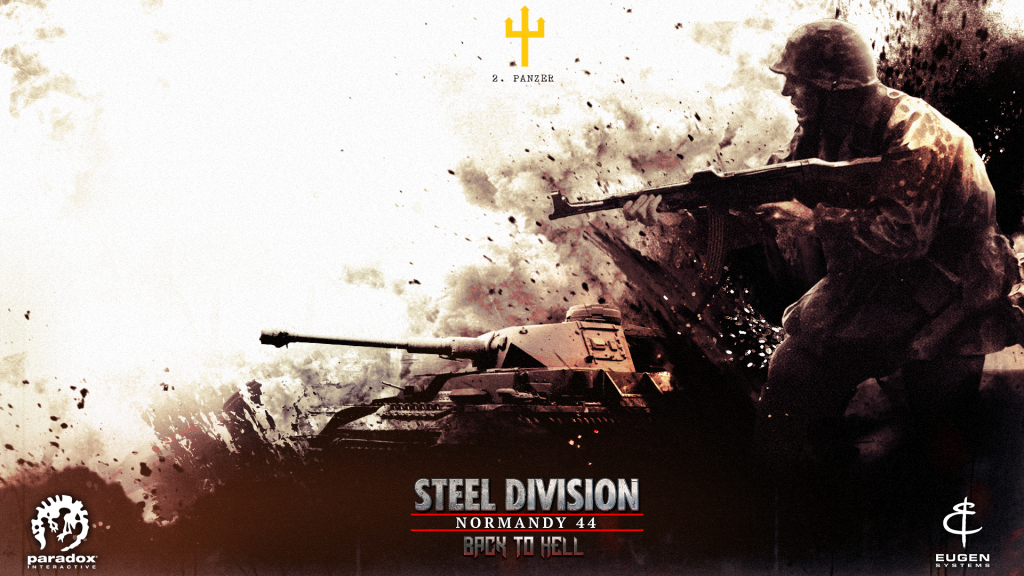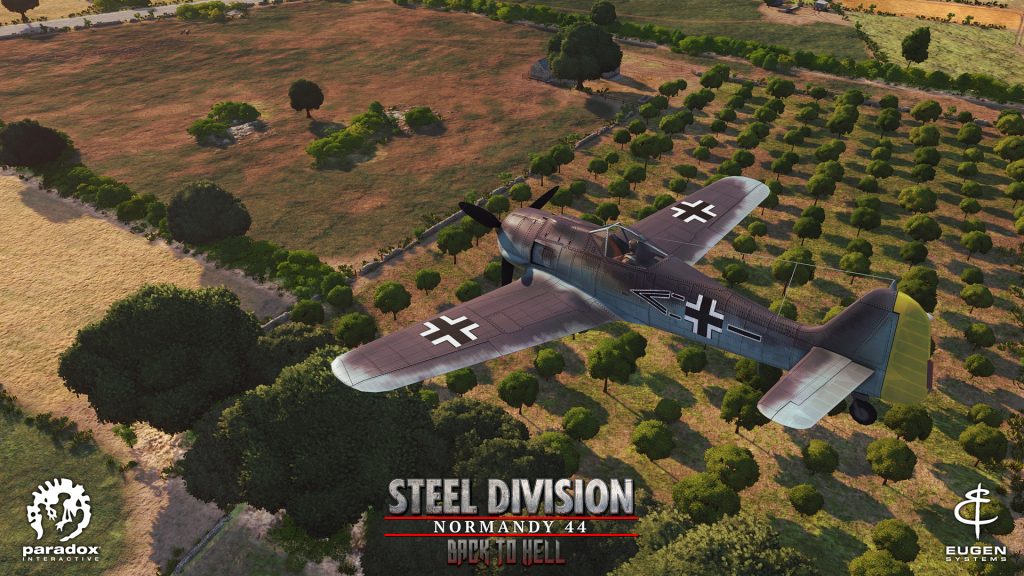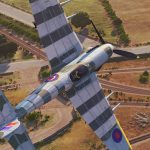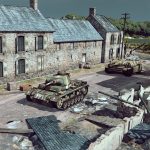Back to Hell, the second DLC for Steel Division: Normandy 44, will feature 4 new divisions, 2 exclusive ace models, as well as 7 historical missions, including 5 in cooperative play. Let’s focus today on the other Viennese unit fighting in Normandy, one the Wehrmacht’s oldest and most elite armored division: the 2. Panzerdivision.
ORIGINS
Formed in October 1935 as one of the rearming German army’s original three Panzerdivisionen, its organizer and first commander was none else than Heinz Guderian, the armored warfare pioneer. Originally raised and trained in Bavaria, the division and its commander took part in the Anschluß, the invasion and annexation of Austria in 1938. From then on, its depot was moved to Vienna where the division was garrisoned. For the rest of the war, it will recruit mostly Austrian personnel, hence earning the nickname “Viennese Division” (“Wiener Division” in German) or being referred in some memoirs as the “Men from Vienna“.
As one of Germany’s oldest Panzerdivision, 2. Panzer took part in all the early campaigns of the war, in Poland, France & Greece. Due to its involvement in Greece, it missed Operation Barbarossa, the invasion of the USSR, but it was only a matter of time before it joined this new theater …WAR IN THE EAST
After returning to Vienna for refitting, 2. Panzer was finally sent to the Soviet Union in October 1941 to reinforce Army Group Center for the final push toward Moscow, codenamed Operation Typhoon (Unternehmen Taifun). One of two fresh armored divisions to join the fight, while most others were already pale shadows of their former selves, 2. Panzer was placed at the tip of the spear. Soon, its losses rose too and in late October it suffered over 100 casualties in a single air attack, a demonstration that the Luftwaffe had lost control of the sky.
On November 30th, 2. Panzer managed to capture the town of Krasnaya Polyana, about 30km North of the Kremlin. Had 2. Panzer got long-range artillery, it could have shelled Moscow from there. But fuel shortage, increasingly bad weather and, mostly, fierce resistance from Rokossovsky’s men prevented it from advancing any further. Krasnaya Polyana was to be the high-water mark held by the Wehrmacht in the USSR, although a reconnaissance patrol from 11. Panzerdivision advanced even closer to Moscow on December 4th, before being beaten back.
From there, the “Men from Vienna” had to fall back in the face of the massive Soviet counter-attack from the Winter 1941-42. Being one of the last Panzerdivision to enter Russia, it was, despite its terrible losses, in a better shape than most others and then remained in Russia when others returned to their depot for refitting. Pulled out from the front line early in the Spring of 1942 for a brief refitting in Smolensk, it picked the serviceable tanks left by 7. Panzer before the latter left for Germany. 2. Panzer was quickly returned to the fight with largely outdated and worn out tanks: 22 Panzer II, 33 Panzer 38(t), 20 Panzer III “lang” as well as 5 Panzer III “kurz” and 2 Befehlpanzer in mid-June 1942.
In early July, it took part in Unternehmen Seydlitz, the reduction of the Rzhev salient and destruction of Soviet 39th Army & 11th Cavalry Corps. A few weeks later, it helped contain the first (of many) Soviet offensives against that same Rzhev salient: by late August, although it had pushed the German front back, the Red Army had failed to break it or liberate Rzhev, and had done so at a staggering cost in human lives. Fightings for Rzhev would continue until March 1943, with the Soviets achieving little gain for even more losses, earning that sector of the Eastern Front the nickname of “Rzhev Meat Grinder”.
Once again pulled out and refitted in the Spring of 1943, 2. Panzer fielded on armored battalion with 60 modern Panzer IV, the other with an assortment of old Panzer II & III (some with short 50mm) for Unternehmen Zitadel, the battle for the Kursk salient. With XLVII. Panzerkorps, 2. Panzer took part in General Model’s Ninth Army‘s main attack as the Northern pincer of the German offensive. For five days, XLVII. Panzerkorps advanced, stalled, repelled counter-attacks (from 2. Panzer‘s Moscow Nemesis, General Rokossovski) and attacked again. But by July 9th, it had only reached the second defensive ring and failed to breach it. On July 10th, a last attempt by the concentrated 2., 4. & 20. Panzer failed again before von Kluge, commander of the Northern pincer, called the offensive off.
When the Red Army finally initiated its counter-offensive, 2. Panzer, although already reduced by Zitadel, was used to cover the retreat, fighting a series of actions alongside the Dniepr River and near Kiev. Completely spent, it was finally pulled out from USSR in January 1944.
FRANCE
Yet, 2. Panzer only passed through Vienna, being sent for rest and refitting in France instead, near Amiens. There, on February 1st, 1944, it got a new commander, Generalleutnant Heinrich Freiherr (= baron) von Lüttwitz. The man shared some traits with American General Patton: an old-school cavalry officer having started his career in a mounted regiment, he became a pioneer in motorization. An excellent scholar, he was also a competitive horseman of international standards and participated in the Olympic Games (Patton in 1912 in the pentathlon, Lüttwitz in 1936 as the leader of the German equestrian team). Both failed to bring any medal home, and in Lüttwitz’s case, he paid it with several years of disgrace.
A recognized trainer of men, Lüttwitz had four months to rebuild his division around a strong core of veterans, get acquainted with new equipment and train his men for the fights to come. At a time when new divisions were rushed to the front with their training period cut by half, it was a luxury few had. Besides, after having been low on the refitting list for new equipment since 1941, 2. Panzer was now lavishly equipped not only with all the regular Panzerdivision dotation (Panther, Panzer IV, Hummel & Wespe) but also with some of the most modern equipment available at the time, such as some of the first SdKfz. 234/2 Puma & Jagdpanzer IV fresh out of the factory lines, and even a few hundred of the new MP 44 (later to be rebranded “Sturmgewehr”) assault rifles. On top of that, two out of its four Panzergrenadier battalions received half-tracks, instead of only one as listed in a regular Panzerdivision’s TO&E. And finally, the division even had an excess of men in its depot! When the Allies landed in Normandy, few divisions in the German army were more prepared to face them. As such, it was classified by Allied intelligence as one of the most dangerous armored division on the Western front.
NORMANDY
On June 8th, D-Day +2, 2. Panzer was ordered to move from Amiens to Normandy, with one isolated company from Funklenk-Abteilung 301 in tow: equipped with Borgward IV remote-control vehicles, this company will remain attached to the “Men from Vienna” for the rest of the campaign.
The movement started early in the morning of June 9th: wheeled elements took the road, while tracked one went by rail. As can be expected, two days later the division was spread over 200+ km, from Alençon to Amiens. The leading elements arrived in Normandy piecemeal from June 12th, immediately thrown into battle as they came, as firemen: at Caumont-l’Eventé the very day of their arrival, two companies of armored scouts were able to prevent a reinforced battalion from US 1st Infantry Division from exploiting a large gap in the German front. The next day, one of the division’s Panzergrenadier regiments saved the day at Villers-Bocage, tipping the balance in favor of Panzer-Lehr & schwere SS-Panzer-Abteilung 101. But von Lüttwitz had to wait until June 20th to have his division finally regrouped, with the Panthers & artillery arriving last.
Then, 2. Panzer was moved entirely near Caumont, watching over the junction between the American & British sectors. Although elements from the division (mostly from Panzerregiment 3) provided support in the counter-attacks against the flank of British Operation Epsom, 2. Panzer wasn’t as heavily engaged in June & July as some other Panzeridivisonen, such as 21. Panzer, Panzer-Lehr or 12. SS-Panzer. On July 30, the division was still considered fit for any mission, offensive or defensive.
As such, 2. Panzer was earmarked as one of the main assault units for the ill-fated Unternehmen Lüttich, the Mortain counter-offensive. Things went bad from the start, since the division’s rearguard, which had just left Caumont to the care of the inexperienced 326. Infanterie-Division, had to turn around to face the onslaught of British Operation Bluecoat. Deprived of some of its units, the core of 2. Panzer charged nonetheless toward Avranches in the first hours of August 7th and, by noon, was the only German armored division to have made significant progress. On the other hand, 116. Panzer commander’s performance in this operation was considered so bad that he was (temporarily) relieved of command, and 2. Panzer was lent its Panther battalion to renew the offensive. But by then, the Allies were reacting: as the main threat, 2. Panzer took the brunt of one of the largest concentration of fighter-bombers (both USAAF & RAF) of the war, being alone the target of some 294 air attacks before night came! Needless to say, 2. Panzer was stopped in its tracks.
The offensive was renewed the next day and for almost a week, in vain, before the German front finally crumbled. With the Americans already turning their left flank, and the Canadians their right one, the German forces in Normandy were on the verge of encirclement while they had spent all their reserves in that last futile counter-offensive. On August 19th, Poles (under Canadian command) & Americans met at Chambois, sealing the Falaise pocket, with 2. Panzer inside. Although reduced in strength, the division was still in a better shape than many others and managed to break out of the pocket, again at a heavy cost.Lüttwitz’ performance, especially considering that he was wounded in action but kept commanding his division nonetheless, brought him praises and a reputation as one of the best commanders during the battle of Normandy. Finally giving up his command to be hospitalized, he was promoted to corps command and replaced temporarily at the head of 2. Panzer by his Ia, Graf Eberhard von Nostitz, then Generalmajor Henning Schoenfeld. Lüttwitz, a brilliant Panzerdivision commander, maybe one the best, was soon to disappoint heavily at the superior level of command …
AFTER NORMANDY
What remained of 2. Panzer regrouped East of Paris, then move to Bitburg in Germany to refit. It absorbed remnants from 352. Infanterie-Division and received a few replacement vehicles, but the German military industry couldn’t replace all that was lost in Normandy and Bielorussia that Summer. 2. Panzer only received enough Panther to roughly equip a company, and mostly StuG in lieu of Panzer IV. With this downsized tank dotation, it was sent back into combat against the Americans during the Ardennes offensive.
Once again spearheading one of the German attacks, it made good progress in the early stage of the offensive, only to be stopped in front of the town of Bastogne, hastily reinforced by the American 101st Airborne Division. After several attacks against the town had failed, 2. Panzer tried to avoid it to reach its objective, the Meuse River. And once again, 2. Panzer advanced further than any other division, arriving in sight of its objective on Christmas Eve. But just like the Kremlin, which legend has that the “Men from Vienna” could see through their binoculars from Krasnaya Polyana yet never reached, the Meuse River was to be another prize just out of their grasp.
Soon, from the hunter, it became the prey. As the most advanced German division, it was the first one to be overwhelmed by the Allied counter-offensive. Cut off, attacked by both British & American troops, lacking fuel for its vehicle, it was nearly destroyed. Four tanks, three assault guns and 200 men were regrouped into a Panzer-Brigade Thueringen which fought until the end of the war, surrendering to the Americans at Plauen & Koetzig.THE 2. PANZERDIVISION INGAME
The Men from Vienna‘s distinctive features are:
- As with its British counterpart, the Desert Rats, 2. Panzer is home to more veteran & elite troops than most other German armored division.
- Among those battle-hardened and decorated soldiers, future Knight Cross holder (for his action in Normandy) Major Horst Rämsch will be featured as an elite Bef.Panzer IV H ace.
- They feature some cards of Sturmgrenadiers & Sturm(grenadier)-Führer, squads entirely equipped with the (highly requested) MP-44 (aka StG-44), still rare in Normandy.
- They can field more mechanized infantry than a regular German armored division (Lehr excepted).
- Their attached Borgward IV company provides it with remote-control vehicles. Those are similar to half-tracks but unarmed and without a pilot, hence can’t be suppressed or routed. Yet they carry 450kg of explosives which can prove devastating when triggered. One of them exploding in a crowd during the Warsaw Uprising killed several hundred people. They can be ordered either to self-destruct on the spot or to move to a specific location or enemy unit before “suiciding”. Yet, they are slow and only lightly armored, and will usually attract a lot of enemy fire when spotted, so their targets must be selected with care.
- Their RECON tab includes a handful of both Aufk.Panzer IV J & Aufk.Panther A, which are identical (but their optics) to their combat counterparts but used in a recon role. They were also the first ones to use Pumas in combat.
- Its AIR tab will include a Fw 190 A4/U4 recon fighter, as a counterpart to the recent such Allied addition (F-5A, Seafire L.III, Mosquito PR.XVI).
- 2. Panzer was one of the few division in Normandy identified as still using, by the Summer of 1944 … some old Panzer II. Those were used as artillery observation tank (Beo.Panzer II C).
- Average in A, 2. Panzer‘s economy is among the strongest in B, but dives down in C.
Steel Division: Normandy 44 – Back to Hell will be available on February 13th, and you can preorder it right here, right now.


![Heinz_Guderian[1]](https://eugensystems.com/wp-content/uploads/2018/01/Heinz_Guderian1-213x300.jpg)
![W-Moscow-LEAD-4d-Sep09[1]](https://eugensystems.com/wp-content/uploads/2018/01/W-Moscow-LEAD-4d-Sep091.jpg)

![Cartemortain2[1]](https://eugensystems.com/wp-content/uploads/2018/01/Cartemortain21-300x240.jpg)
![1280px-Battle_of_the_Bulge_5th[1]](https://eugensystems.com/wp-content/uploads/2018/01/1280px-Battle_of_the_Bulge_5th1-300x175.jpg)






No Comments